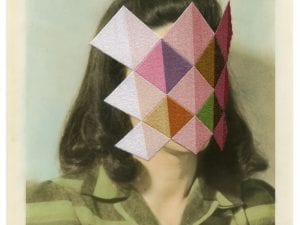London College of Communication (LCC) graduate Juno Calypso creates self-portraits in which she performs under the guise of a persona named Joyce. Based in London, the artist uses this character to explore modern rituals of seduction and beauty within elaborately staged photographs. Calypso’s distinctive work is recognised for its investigations into the laboured construction of femininity. Her most recent photographic and video project, displayed at 71A Gallery this month, is set within a Pennsylvanian honeymoon hotel. In 2014, we featured the artist in The Next Generation – a survey of emerging photographers from LCC. Calypso has since exhibited in London, New York and Miami, alongside appearances in The British Journal of Photography, The Guardian, Dazed & Confused, The Sunday Times, VICE and The Huffington Post.
A: What is it about modern rituals associated with beauty and seduction that interest you?
JC: They interest me because they are all things I do or have done before. I’m drawn to the aesthetic of it all – the strange devices, products and tools. The way it all feels like a bad sci-fi film. I’m also interested in the way we always perform these rituals alone, or alone with a stranger in a candle lit treatment room.
A: How much is physicality, and the contrast between the animate and inanimate, the focus of your images?
JC: I like to give as much importance to the inanimate as the animate. There’s always one main prop which underscores the whole picture. It’s independent yet dependent on the person. Joyce herself is always inanimate. She’s becoming as stale and joyless as the objects around here.
A: Your works often feature a distinct colour palette. How do specific tones reflect the themes explored in your self-portraits, such as ideas relating to beauty, domesticity and the constructed feminine?
JC: Thank you I’m glad it’s becoming distinct. I love the colour pink and our conflicted relationship with it. People feel weird about the colour pink. It can be seen as innocent and juvenile, but also embarrassing and highly sexual – when we think about blushing, sexual organs, tongues and lips. If red is love, maybe pink represents suspense. Longing, yearning for pleasure. The hope of fulfilment. I think it relates well to the idea of constructed femininity because we associate the colour pink as something artificial – a colour not often found in nature.
A: There is a subtle undertone of isolation in your photographs. Preparation for your latest work included travelling alone to a Pennsylvanian honeymoon hotel. Owing to this experience, is inducing a feeling of isolation a conscious effect, and if so, does this relate to the isolative process of beautification?
JC: Yes definitely. Inducing the isolation is probably a conscious decision now, but at the start of the project it was just the way I liked to work. I preferred being alone and couldn’t concentrate with anyone else around – it’s funny because I used to be exactly the same with getting ready to go out. I hated getting ready with a big group girls or at someone else’s house. The result never felt as perfect and it would made me itch inside.
A: Is your work in self-portraiture an attempt to subvert the idea that beautification and seduction are processes to pleasure others? Does your work have any feminist connotation or inspiration behind it?
JC: It’s a good point. It’s very true – these rituals are always foremost for ourselves. And I find that self-love and affection is more interesting to look into. It’s like when women say the best part of going out is getting ready – a male gaze free zone. I’ve been reading a lot into intersectional feminism, and so while my images have their limitations because they’re only telling my story – I hope that there is an emotion in them that can be universally relatable – feelings of female desire, and disappointment.
A: In 2014 you appeared in Aesthetica’s The Next Generation series? How has your practice progressed since then?
JC: It’s been a really good year. Going to Pennsylvania was a significant shift – before that I’d always been shooting in my grandma’s house or places rented not far from home. This was the furthest I’d gone alone, and the most surreal. It scared me the most so I knew I was onto something. When I got back to London I was selected by Tom Hunter to have my first solo show at Flowers Gallery in London’s Cork Street, where I exhibited the images for the first time, so all the stress paid off in the end.
Juno Calypso, 2 – 4 October, 71A Gallery, 71A Leonard Street, EC2A 4QS
Find out more at www.71alondon.com.
Visit the artist’s website at www.junocalypso.com.
Follow us on Twitter @AestheticaMag for the latest news in contemporary art and culture.
Credits
1. Juno Calypso, 12 Reasons You’re Tired All The Time, 2013. Courtesy of the artist and 71A Gallery.





